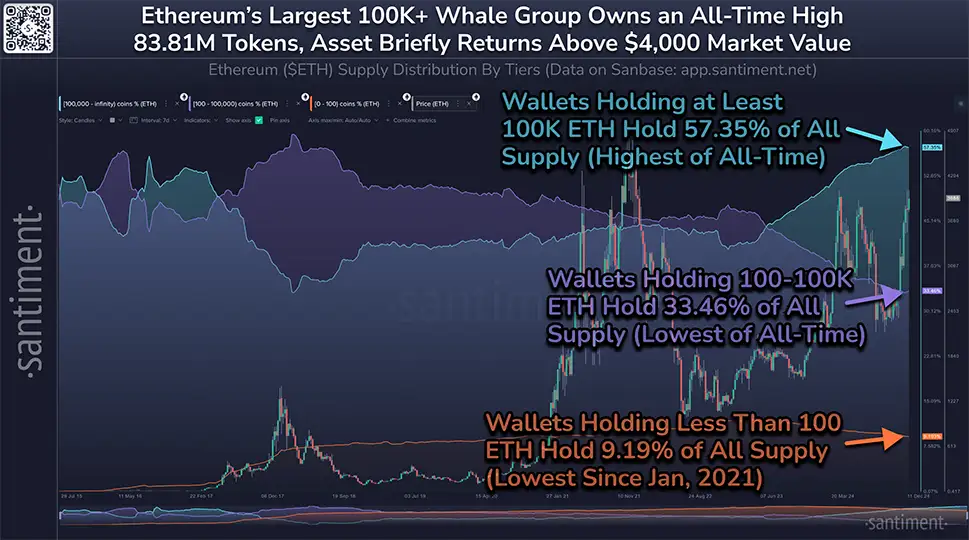Ethereum’s whale dominance has reached an all-time high, and this could have significant consequences for the future of the network. While smaller investors hold less than ever, whales—large ETH holders—are quietly increasing their positions.
This raises an important question: Is this the beginning of another bull run, or is there something else at play?
Currently, 104 wallets hold over 100,000 ETH each, making up 57.35% of Ethereum’s total supply—the highest percentage ever recorded. In contrast, mid-sized investors (those holding between 100 and 100,000 ETH) now control just 33.46%, the smallest share in history.

Smaller investors are also seeing their influence shrink.
Wallets holding fewer than 100 ETH now account for just 9.19% of the total supply, the smallest proportion since January 2021. This shift has been building since late 2022, when large investors began accumulating more ETH. It’s clear that the whales are positioning themselves for the long term, potentially anticipating a major market shift.
This isn’t the first time whale activity has influenced Ethereum’s price. In late 2020 and early 2021, similar whale accumulation sparked a bull run that saw ETH reach new heights. However, there’s also a cautionary tale. When whale dominance peaked in 2022, it was followed by a sharp price correction, reminding us that whale-driven markets can be volatile.
A Look at the Technicals
Ethereum is currently priced at $4,015, with immediate resistance at $4,109. The 4-hour chart shows the 20-day moving average (MA) at $3,931, while strong support lies at $3,575, backed by the MA 200.
The technical indicators show cautious optimism. The Relative Strength Index (RSI) stands at 58.42, meaning ETH is not yet in overbought territory. However, the On-Balance Volume (OBV) at -44.94 shows some hesitation among investors.
Looking at investor behavior, data from IntoTheBlock reveals that 74% of Ethereum holders have held their ETH for over a year, indicating strong confidence in the asset. Short-term holders are divided as follows:
In terms of profitability, the outlook is positive:
However, around 4.27 million addresses are holding 1.21 million ETH at a loss, with most of these purchases made between $4,093 and $4,891, which is close to the current price.
So, what does all of this mean for the average investor? There are two possible scenarios. On the bullish side, the whales’ ongoing accumulation points to long-term optimism. If this trend continues, ETH could rise to the $4,500–$5,000 range.
However, there’s also a risk. With so much of the supply controlled by a few wallets, the market becomes more vulnerable. A coordinated sell-off by these whales could lead to a sudden price drop. It’s something to keep a close watch on as Ethereum’s future unfolds.
In the end, Ethereum whale dominance serves as a reminder that the biggest players still have the most control in this market. Whether this dominance leads to a new bull run or a market correction remains to be seen.
Dogecoin (DOGE), the internet’s most popular meme coin, dropped by 13% last week, making many…
The long-running Ripple vs SEC battle might finally be wrapping up this year. With settlement…
A new post by Italian crypto expert Fabio Zuccara is turning heads in the XRP…
Ethereum co-founder Vitalik Buterin has unveiled an ambitious new proposal that promises to turbocharge Ethereum’s…
Bitcoin has hit a tough resistance level after testing the top of its current trading…
May 19th is turning out to be nothing like a regular (boring) Monday - everything…